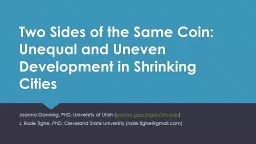

Joanna Ganning PhD University of Utah joannaganningutahedu J Rosie Tighe PhD Cleveland State University rosietighegmailcom Shrinking Cities Research Context 2 Economic Decline ID: 431622
Download Presentation The PPT/PDF document "Two Sides of the Same Coin: Unequal and ..." is the property of its rightful owner. Permission is granted to download and print the materials on this web site for personal, non-commercial use only, and to display it on your personal computer provided you do not modify the materials and that you retain all copyright notices contained in the materials. By downloading content from our website, you accept the terms of this agreement.
Slide1
Two Sides of the Same Coin: Unequal and Uneven Development in Shrinking Cities
Joanna Ganning, PhD, University of Utah (
joanna.ganning@utah.edu
)
J. Rosie
Tighe
, PhD, Cleveland State University (rosie.tighe@gmail.com)Slide2
Shrinking Cities: Research Context
2
Economic Decline
Beginnings in Europe
How to bring to US Context?Slide3
Land Stabilization
3
Literature presents a range of solutions
Land banking
Urban agricultureVacancy stabilization
Adaptive reuseSlide4
Permanent Shrinkage?
4
But many cities are shrinking decade upon decade.
What to do about “permanent” shrinkage?
Comprehensive Planning?“Smart Decline”
Youngstown, OH is only city to planBut implement?Slide5
Framework & Contribution
Hypothesis
: Long-term decline is arrived at through a place-specific inability of planning and policy to intervene or remediate in the process of or effects of inequitable urban decline.
Today’s Presentation
: Digging through the historical and contemporary data that paints this picture for a case study city, St. Louis, MO.
Future Work
: Quantitative analysis on a sample of shrinking cities, testing the association between intra-city segregation in 1970 and the degree of population decline and change in SES inequality.Slide6
A brief history
6
Inequitable Urban
Development & DeclineSlide7
The Great Migration
7Slide8
Segregation
8Slide9
Industrial Decline and Blight
9Slide10
Discrimination
10Slide11
The Case of St. Louis (http://
www.bbc.com/news/magazine-17361995)
Non-White Population, 1970
Population Change, 1970-2010Slide12
12
Planning & Policy History: St. LouisSlide13
Urban Renewal in St. Louis
13Slide14
Urban Renewal
14
3 interstate highways built through St. Louis
Hundreds of acres of land cleared
More than 6000 public housing units constructedBut more than 35000 units demolished
Those with means left; those without stayedSlide15
The Legacy
15
A highly recommended resource: http://www.pruitt-igoe.com/Slide16
Race by Census
Trac
, 1970t
Team 4 Designated
Zones, 1973
16
Triage in St
.
LouisSlide17
Triage in St. Louis
Reconstruction (Black)
Maintain your property and yard and urge your neighbors to do so. Don’t make major investment in properties without checking with City to be sure it fits any plans for future rehabilitation or reconstruction….In absence of agreed-upon plan, discourage scattered new construction; uncertainty is unfair to investor and ultimate consumer. Investigate concept of land-banking to allow assembly of land for reconstruction without penalty to existing owners. (Saint Louis City Plan Commission 1973, 111)
Improvement (White)
The Development Program recommends a higher relative priority, than has heretofore existed, to action programs designed to stop the spread of deterioration and abandonment into those still attractive neighborhoods which are along the edge of seriously deteriorated areas and threatened by the insidious expansion of blight. It makes little sense for millions of public and private dollars to be expended on reconstruction of neighborhoods while at the same time allowing stable neighborhoods to fall into decline. (Saint Louis City Plan Commission 1973, p. 155)Slide18
18
As a result of the Team Four Plan, [the City] spent hundreds of millions of dollars in the Central West End to stabilize and to create a barrier between North and South St. Louis so the [few] black people in South St. Louis [at that time] could never gain political power
.
– State Representative Charles Quincy TroupeSlide19
Shrinking Cities
While there are familiar threads of urban, racial inequality, the story of each city is unique.
Detroit:
LeDuff
(2013), Galster (2012), Clark (2014)Richmond: Silver (1984)
One has to wonder if there is a pattern. Does the city act as a tourniquet, and at multiple scales? Did cities as a whole decline because escape was possible for some?
Did the 2 sided coin appear because of intra-city policy?
Can we prove that long-term decline is more prevalent among cities where planning, policy, and/or development followed racial lines?